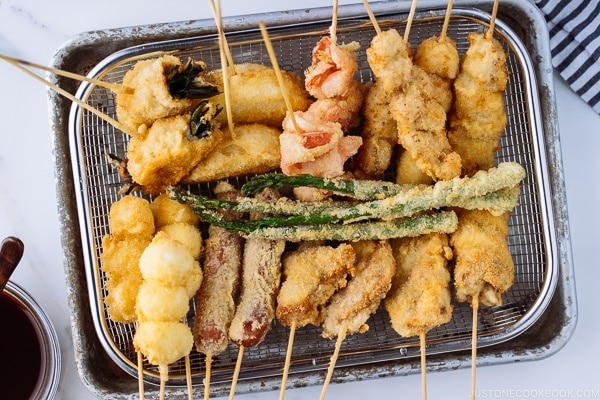Kushikatsu (Kushiage)
5.0
(8)
Your folders
Your folders
Prep Time: 30 minutes
Cook Time: 25 minutes
Total: 55 minutes
Servings: 4

Ingredients
Export 15 ingredients for grocery delivery
Instructions
Step 1
Gather all the ingredients. You will also need a pack of 6-inch bamboo skewers.
Step 2
For the kushikatsu sauce, combine all the sauce ingredients in a small bowl: 4 Tbsp Worcestershire sauce, 2 Tbsp ketchup, 2 Tbsp water, 2 tsp soy sauce, and 2 tsp sugar. Whisk well. Depending on the amount of skewers you‘re preparing, multiply the sauce ingredients as you need.
Step 3
Boil water in a small saucepan. Gently submerge 9 quail eggs into the boiling water. Cook for 3 minutes and transfer to iced water to let cool. Peel the eggs and set aside.
Step 4
Put 2 cups panko (Japanese breadcrumbs) in the food processor. Process to make the panko a finer texture.
Step 5
Snap off the ends of 6 asparagus spears and discard the bottom.
Step 6
Cut ½ onion into 4 wedges.
Step 7
Discard the ends of 1 bunch garlic chives (Chinese chives or Nira) and cut them crosswise into 4 equal pieces.
Step 8
Cut 1 piece boneless pork loin chops (½-inch thick) into 4 pieces and pound the meat with the back of the knife to tenderize the meat.
Step 9
Cut ½ chicken breast diagonally (which should be against the grain) about ½ inch thick. Then, season with Diamond Crystal kosher salt and freshly ground black pepper.
Step 10
Skewer the chicken and pork as if you are stitching, starting from one end of the meat, move the skewer downward and upward alternately.
Step 11
Equally divide the garlic chives and put them on each end of the 4 pieces sliced pork belly on the cutting board. Roll the garlic chives from one end to the other. Skewer the seam so the pork belly slice will stay in place.
Step 12
Carefully skewer the 2 sausages and the quail eggs.
Step 13
For ½ cup sushi ginger (gari), drain it and skewer it as well. For the onion wedges, skewer them toward the core.
Step 14
Prepare all the skewered ingredients on a plate/tray.
Step 15
Whisk 1 large egg (50 g each w/o shell) in a large bowl. Add all but ¼ cup of the 1 cup water, leaving the rest in the measuring cup.
Step 16
Then, add 1 cup all-purpose flour (plain flour) into the bowl. Whisk all together. With the remaining water, slowly drizzle in water until your batter is the right consistency.
Step 17
The batter should be runny but thick, and when you dip your finger, it should be covered with the batter. Adjust with more water, if needed. Place the panko in a shallow bowl/tray.
Step 18
Bring 3½ cups neutral oil to 340–360ºF (170–180ºC). When the oil is hot and ready for deep-frying, you want to start with the vegetables or more plain food first, leaving the meat or strong flavor items for later. That way, the oil stays clean for the vegetables/ plain food, as the oil will turn darker and more flavorful when you start deep-frying the savory food.
Step 19
Dredge the ingredients in the batter and then the panko. Remove the excess panko and deep-fry until crisp and golden brown.
Step 20
Scoop up the panko breadcrumbs between batches to keep the oil clean. Burnt panko will darken your oil, which will change its taste.
Step 21
Continue with other ingredients. Use a spoon, if you have a hard time coating the batter.
Step 22
Deep-fry the meat and seafood at the end.
Step 23
Drain the deep-fried food on a wire rack or paper towel. Serve immediately with the kushikatsu sauce and ichimi togarashi (Japanese chili pepper).
Step 24
Keep the leftovers in an airtight container and store in the refrigerator for up to 3 days and in the freezer for up to a month.